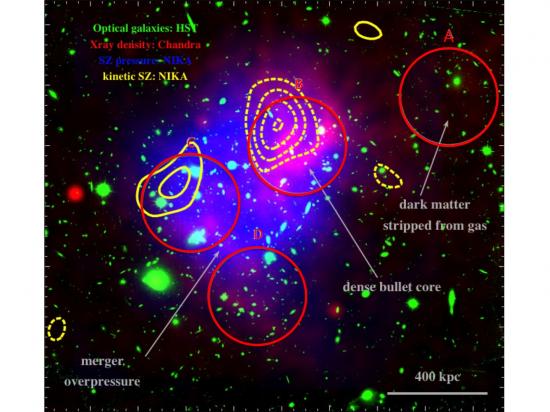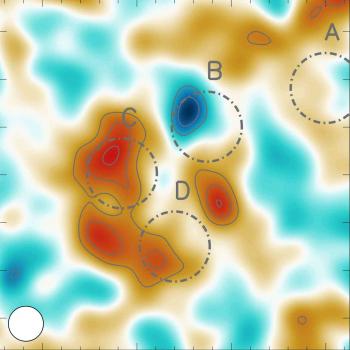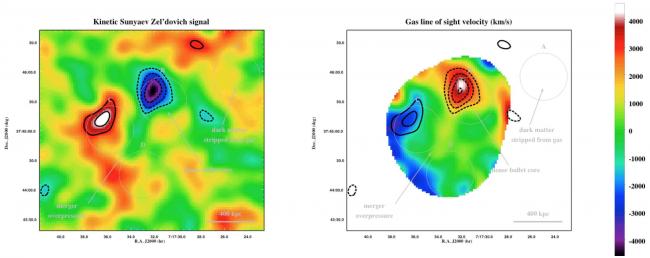A team of researchers led by Rémi Adam (Laboratoire Lagrange - OCA, UCA, LPSC Grenoble, CNES), Iacopo Bartalucci and Gabriel Pratt (Astrophysics Department- AIM Laboratory at CEA-Irfu) obtained for the first time an image of the gas velocity in colliding clusters of galaxies with NIKA [1], a new generation millimeter camera, at the focus of the 30 m diameter IRAM telescope of Pico Veleta (Spain). NIKA observations, which give accurate mapping of hot gas velocity in clusters, provide a new way to study the collision of clusters of galaxies, responsible for the most energetic events in the Universe after the Big Bang. This work is being published in the journal Astronomy & Astrophysics..
Clusters of galaxies: key to the formation of large structures.
The Universe in which we live today was shaped by the formation of large structures, vast concentrations of matter that began to form by gravitational collapse some 14 billion years ago, just after the Big Bang. Today, the largest known gravitationally bound objects are the clusters of galaxies that constitute the fundamental parts of our observable Universe. According to the current cosmological model, clusters of galaxies, despite their name, are actually mainly composed of dark matter (~ 85%) and ionized hot gas (~ 12%), with only a few percent of their mass contained in galaxies themselves. For this reason, the process of cluster formation is mainly dominated by the gravitational collapse of the dark matter, the gas and the galaxies just accompanying this process. During assembly, the clusters can collide with one another at high speed. These mergers are the most energetic events since the Big Bang and they are fundamental to understanding how the structures in the Universe are assembled and evolved.

Multi-wavelength image of the MACS J0717.5 + 3745 cluster, showing the distribution of galaxies (in green, Hubble Space Telescope data), gas density (in red, X-rays, Chandra data), the gas electron pressure (in blue, NIKA camera) and the kSZ signal (yellow contours, NIKA). The red circles (A, B, C and D) indicate the position of the main sub-clusters. At the distance of the cluster (about 5 billion light-years), the image size corresponds to about 5 million light-years.
An Instrumental Challenge
One way to study the velocity of gas in clusters is to measure the fingerprint of this motion in cosmic diffuse background radiation (CMB) by using the kinetic Sunyaev-zel'dovich (kSZ) effect. This effect arises from the modification of the energy of the CMB photons when they interact with the electrons of the intra-cluster gas moving at high velocity (Doppler shift). The kSZ effect is the only known way of directly measuring the particular velocity of objects at cosmological distances because the CMB radiation from the universe itself provides an absolute reference for measurement. There is also a thermal counterpart (the Sunyaev-Zel'dovich thermal effect, tSZ) which is commonly used to measure the gas pressure in the clusters. The kinetic SZ effect is much more difficult to observe and only a handful of measurements of low statistical significance has been obtained so far.
The NIKA consortium, headed by Alain Benoît and Alessandro Monfardini (Institut Néel), has built, tested and commissioned a prototype of a new camera called NIKA ("New IRAM KIDs Array") [1], a mosaic of KID detectors (KID for Kinetic Inductance Detectors). This camera, installed at IRAM's 30m telescope, observes simultaneously in two 150 and 260 GHz frequency bands, allowing astronomers to extract both tSZ and kSZ signals when observing clusters of galaxies. Motivated by the scientific challenge and high performance of NIKA, the team decided to attempt a measurement of the kSZ effect by mapping one of the most violent clusters, MACS J0717.5 + 3745, located at a redshift of 0.55, that is a distance of several billion light years from Earth.
The data revealed that the two main sub-clusters of MACS J0717.5 + 3745 are falling towards each other with a very large momentum. According to Rémi Adam: "The simple detection of the kSZ effect is already an excellent result in itself, but when we realized that we were able to get a map, it was a tremendous success for us."
In addition to the NIKA observations, this procedure required the use of X-ray observations by XMM-Newton and Chandra satellites to measure the velocity of the cluster and to extract the map from the gas velocity with respect to the CMB reference. The obtained image is not easy to interpret because it depends on different modeling assumptions. It is nevertheless particularly striking because it presents an image of the gas motion for the first time in a very distant galaxy cluster.
These results pave the way for a new method for the study of cluster fusion thanks to the high angular resolution and high sensitivity of instruments, such as the NIKA prototype camera. A new larger camera NIKA2 [2], was installed in October 2015 at IRAM and is now operational.
Contacts : Gabriel PRATT and Iacopo Bartalucci
Publication :
« Mapping the kinetic Sunyaev-Zel’dovich effect toward MACS J0717.5+3745 with NIKA »
R. Adam, I. Bartalucci, G.W. Pratt et al. (2017) , A&A (en cours de publication)
for an electronic version :  arxiv.org/abs/1606.07721
arxiv.org/abs/1606.07721
See : the IRAM press release (9 January 2017)
- the NIKA2 consortium website
- the IRAM website (NIKA et NIKA2)
[1] The NIKA instrument (New IRAM KID Arrays) instrument is a dual band camera (150 and 260 GHz) consisting of a kinetic detector mosaic (KID) for observing millimeter radiation at the 30m telescope focus at IRAM (Institute of Radio Astronomy Millimetric). NIKA was built by the Institut Néel, LPSC, IPAG and IRAM Grenoble, and the University of Cardiff. NIKA comprises two focal planes: 132 pixels at 120-170 GHz and 224 pixels at 200-280 GHz and simultaneously covers in both bands the same portion of the sky with an instantaneous field of view of 2 arc-min.
[2] NIKA2 NIKA2 is issued from the NIKA prototype which has been successfully used at Pico Veleta. Imaging in two frequency bands is obtained by simultaneously reading a mosaic of 1000 pixels at the wavelength of 2 mm (150 GHz) and from 2 x 2000 pixels to 1.2 mm (260 GHz) . The two arrays at the wavelength of 1.2 mm allow the measurement of the linear polarization in this band
The NIKA consortium includes scientists, engineers and technicians from the Institut Néel, IPAG, LPSC, IRAM, IAS, CEA, IRAP, IEF, IAP, Paris, LAM, UCL, Cardiff University, ESO, Laboratoire Lagrange (OCA), and the IAC.
- The NIKA consortium was supported by ANR NIKA, ANR NIKA2Sky, ERC ORISTARS, FOCUS, ENIGMASS, INP, INSIS, INSU, IN2P3, and UGA.
The results presented here involve scientists from JPL, RIT, Arizona State University, the University of Arizona and the Università degli Studi di Roma 'Tor Vergata'.
Redaction : Consortium NIKA, J.M. Bonnet-Bidaud
• Structure and evolution of the Universe › Evolution of the large structures and galaxies





